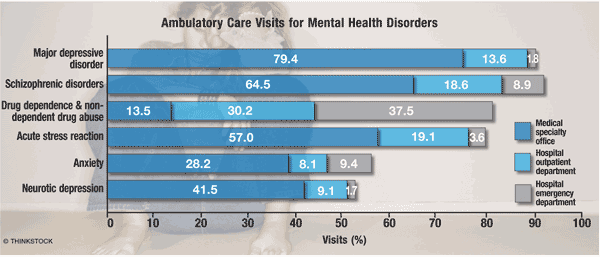According to the 2007 Behavioral Risk Factor Surveillance System (BRFSS) survey, 40% of U.S. residents in 35 states had serious psychological distress. Of these, 38% received mental health services, 53% received no treatment, and a greater percentage were women, unmarried, and likely to live in poverty. Individuals with serious psychological distress were more likely to be obese, smoke, and be diagnosed with heart disease. BFRSS Health Related Quality of Life data for 2004–2008 indicate that U.S. adults experienced 3.4 mentally unhealthy days and 10% of adults experienced 14 or more mentally unhealthy days in the past 30 days. Frequent mental distress—including stress, depression, and problems with emotions—was experienced by 9.4% of U.S. adults in 1993–2001 and 2003–2006 combined.

Anxiety: The estimated lifetime prevalence of any anxiety disorder exceeds 15%, while the 12-month prevalence is more than 10%. Prevalence estimates of anxiety disorders are generally higher in developed countries. Most anxiety disorders are more prevalent in women than in men.
Depression: According to the World Health Organization, unipolar depression was the third most important cause of disease burden worldwide in 2004, and it is estimated that, globally, depression will be the second leading cause of disability by the end of 2020. In the U.S., depression is the most common type of mental illness (affecting 26% of adults). In any 2-week period in 2005–2006, 5.4% of individuals older than 12 years suffered from depression. In 2006–2007, 7.9 million ambulatory care visits were made to physicians’ offices and hospital outpatient and emergency departments for the treatment of major depressive disorder (MDD) as the primary diagnosis. The average length of hospital stay for MDD was 6.3 days. National surveys found that lifetime MDD was more prevalent in women (11.7%) than in men (5.6%). Individuals aged 40 to 59 years had the highest prevalence (7.3%) of all age groups.
Schizophrenia: Worldwide, the prevalence of schizophrenia is between 0.5% and 1%. The first episode has been documented to occur earlier in men (mean age 21 years) than in women (27 years). In 90% of male and 20% of female patients with schizophrenia, the disorder manifests for the first time by 30 years of age. Patients with schizophrenia are vulnerable to suicide.
Commentary: More than two-thirds of BRFSS survey respondents were confident that treatment can help people with mental illness lead a normal life. Respondents with (25%) and without (59%) mental illness had significant differences in opinion with respect to how sympathetic and caring people were toward individuals suffering from mental illness.
To comment on this article, contact rdavidson@uspharmacist.com.






